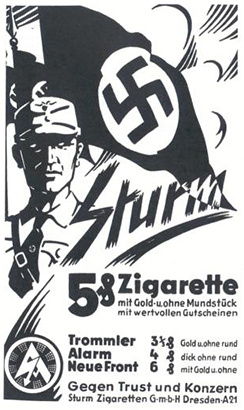West is a German brand of cigarettes, currently owned and manufactured by Imperial Brands.

Candy cigarettes are a candy introduced in the late 19th century made out of chalky sugar, bubblegum or chocolate, wrapped in paper and packaged and branded so as to resemble cigarettes. Some products contain powdered sugar hidden in the wrapper, allowing the user to blow into the cigarette and produce a cloud of sugar that imitates smoke, which comes out of the other end.

Reemtsma Cigarettenfabriken GmbH is one of the biggest tobacco and cigarette manufacturing companies in Europe and a subsidiary of Imperial Brands. The company's headquarters is in Hamburg, Germany.

More is an American brand of cigarettes, owned and manufactured by the R.J. Reynolds Tobacco Company in the United States, Japan Tobacco in the European Union and PMFTC in the Philippines.

Memphis is an Austrian brand of cigarettes, currently owned and manufactured by "Austria Tabak", which is owned by the Gallaher Group, a subsidiary of Japan Tobacco.

f6 is a German cigarette brand owned by Philip Morris International and produced by the f6 Cigarettenfabrik Dresden GmbH.

In the early 20th century, German researchers found additional evidence linking smoking to health harms, which strengthened the anti-tobacco movement in the Weimar Republic and led to a state-supported anti-smoking campaign. Early anti-tobacco movements grew in many nations from the middle of the 20th century. The 1933–1945 anti-tobacco campaigns in Nazi Germany have been widely publicized, although stronger laws than those passed in Germany were passed in some American states, the UK, and elsewhere between 1890 and 1930. After 1941, anti-tobacco campaigns were restricted by the Nazi government.

The Sturm Cigarette Company was a cigarette company created by the Nazi Party's Sturmabteilung (SA). The sale of its cigarettes provided the SA with operating funds and a channel for political messaging. Coercion and violence were used to increase sales.

In Germany, smoking is widespread and is subject to very few and lax regulations compared to other countries in Europe. Tobacco taxes in Germany are among the lowest in Europe. Germany ranks last on the Tobacco Control Scale and has sometimes been referred to as the "smoker's paradise" of Europe. According to German addiction researcher Heino Stöver, Germany has "[...] more cigarette vending machines than any other country in the world."
Fritz Balduin Lickint was a German internist and social democrat, who investigated scientifically health problems and social problems related to alcohol and tobacco, described in the 1920s cancer of the lung from smoking, and the cancer pathway alongside the respiratory and upper digestive tract. In 1925 he published about an increase of gastric ulcer and stomach cancer in smokers. All his life Lickint was an engaged social democrat and member of the union "social democratic physicians". Because of his political attitude he lost his job at the Chemnitz hospital in 1934, shortly after the Nazis came into power, and was conscripted to military service in 1939 as a basic aidman. Not before 1945 he was able to return to his work as a hospital physician and later became hospital director. Lickint was one of the first physicians describing physical and psychological tobacco dependence as a disease which needs treatment, suggesting a number of therapies. He also pointed to the "anti-social behavior of many smokers, polluting ambient air recklessly and harming the health of other people". Lickint created the term "passive smoking". The Nazis usurped these thoughts, but simultaneously supplied soldiers with cigarettes and cooperated with the German tobacco company Reemtsma, also in Austria. Later the propaganda of the tobacco industry in Austria and Germany traced the origin of the non-smoking movement back to the Nazi time, when actually more cigarettes were smoked than ever before. In fact the movement against alcohol and nicotine had started in the social democratic party at the beginning of the 20th century, even though research and ideas of Fritz Lickint were also used in the anti-tobacco movement in Nazi Germany. Though he was not the first to publish statistical evidence suggesting a link between cancer and tobacco consumption, in 1929 Lickint published the most thorough case-series study at the time. In 1939, Lickint in collaboration with The Reich's Committee for the Struggle against Addictive Drugs and the German Antitobacco League published Tabak und Organismus, a 1200-page volume covering 8000 publications which is considered to be the largest scholarly compilation on the ills of tobacco at the time. This in turn earned him the title as the physician "most hated by the tobacco industry." Lickint argued that tobacco was highly addictive and that its usage was responsible for thousands of cancers in Nazi Germany.

Muratti is a brand of cigarettes, currently owned and manufactured by Philip Morris International. Several Muratti variants have been introduced over the years and were also sold as Ambassador, Ariston, Cabinet, Gentry, Iplic, Peer and Regent.

Atika was a German cigarette brand which was owned and manufactured by Reemtsma, a subsidiary of Imperial Tobacco. Production of cigarettes under the "Atika" brand was discontinued in 2016.
Belinda is a Dutch brand of cigarettes currently owned and manufactured by British American Tobacco.
Cabinet is a German brand of cigarettes, currently owned and manufactured by Reemtsma, a subsidiary of Imperial Brands. It is mainly sold and found in the New states of Germany.

Juno was a German brand of cigarettes, owned and manufactured by Reemtsma, a subsidiary of Imperial Tobacco. The brand was discontinued in 2016.

Karo is a German brand of filterless cigarettes, currently owned and manufactured by Altria. Karo is the German word for "diamond".

R6 is a German brand of cigarettes, currently owned and manufactured by Reemtsma, a subsidiary of Imperial Brands.

Reval is a German brand of cigarettes, currently owned and manufactured by Reemtsma, subsidiary of Imperial Tobacco.
Roth-Händle is a former tobacco manufacturing company based in Lahr, Germany. The brand is now managed by Reemtsma, a subsidiary of Imperial Tobacco since 2002.

Lexington is a Luxembourgish brand of cigarettes, currently owned and manufactured by Landewyck Tobacco. In South Africa, it is sold by BAT South Africa, a subsidiary of British American Tobacco.















